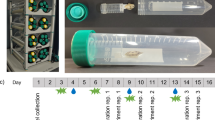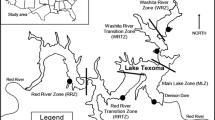Abstract
Dreissenid mussels are successful aquatic invaders which have spread rapidly throughout North America following their arrival from Eurasia approximately 35 years ago. Reservoirs in central Texas have been more recently invaded by zebra mussels and these populations represent the southernmost edge of this species’ current distribution in North America. The purpose of this study was to examine the distribution and population dynamics (recruitment and mortality) of zebra mussels in Canyon Lake and the effect of high temperatures and low dissolved oxygen on mortality of zebra mussels in three different Central Texas lakes (Canyon, Belton, and Stillhouse Hollow). Recruitment, both larval densities and juvenile settlement, varied with temperature within and between years. The highest settlement rate and lower mortality were associated with lower temperatures (e.g., year or lake with lowest number of days ≥ 30 °C), whereas hypoxia likely caused high mortality at greater depths in Lake Belton. Although higher summer temperatures seem to limit zebra mussels, their population has continued to increase and expand in Canyon Lake since the initial invasion, but at considerably lower densities than higher latitude populations This study improves our understanding of factors driving and limiting zebra mussel population dynamics in low latitude lakes, which will help to inform management decisions.








Similar content being viewed by others
Data availability
The data that support the findings of this study are available from the corresponding author (ANS) upon reasonable request.
References
Alexander JE, McMahon RF (2004) Respiratory response to temperature and hypoxia in the zebra mussel Dreissena polymorpha. Comp Biochem Physiol Part A Mol Integr Physiol 137:425–434
Allen YC, Thompson BA, Ramcharan CW (1999) Growth and mortality rates of the zebra mussel, Dreissena polymorpha, in the lower Mississippi River. Can J Fish Aquat Sci 56:748–759
Arterburn HM, McMahon RF (2022) Population and reproductive dynamics of zebra mussels (Dreissena polymorpha) in warm, low-latitude North American waters. Biol Bull 242(3):207–221
Balogh C, Muskó IB, Tóth LG-, Nagy L (2008) Quantitative trends of zebra mussels in Lake Balaton (Hungry) in 2003–2005 at different water levels. Hydrobiologia 613(1):57–69. https://doi.org/10.1007/s10750-008-9472-3
Benson AJ, Raikow D, Larson J, Fusaro A, Bogdanoff AK, Elgin A (2022) Dreissena polymorpha (Pallas, 1771): U.S. geological survey, nonindigenous aquatic species database, Gainesville, FL, https://nas.er.usgs.gov/queries/FactSheet.aspx?speciesID=5
Bij de Vaate A (1991) Distribution and aspects of population dynamics of the zebra mussel, Dreissena polymorpha (Pallas, 1771), in the lake IJsselmeer area (The Netherlands). Oecologia 86:40–50
Boeckman CJ (2011) Characterizing zebra mussel (Dreissena polymorpha) condition, populations, and community effects in Oklahoma habitats. Dissertation, Oklahoma State University
Churchill CJ (2013) Spatio-temporal spawning and larval dynamics of a zebra mussel (Dreissena polymorpha) population in a North Texas reservoir: implications for invasions in the southern United States. Aquat Invasions 8:389–406
Churchill CJ, Hoeinghaus DJ, La Point TW (2017) Environmental conditions increase growth rates and mortality of zebra mussels (Dreissena polymorpha) along the southern invasion front in North America. Biol Invasions 19:2355–2373
Cohen AN (2008) Potential distribution of zebra mussels (Dreissena polymorpha) and quagga mussels (Dreissena bugensis) in California. San Francisco Estuary Institute
Conover WJ, Johnson ME, Johnson MM (1981) A comparative study of tests for homogeneity of variances, with applications to the outer continental shelf bidding data. Technometrics 23:351–361. https://doi.org/10.1080/00401706.1981.10487680
Dolle K, Kurzmann DE (2020) The freshwater mollusk Dreissena polymorpha (zebra mussel): a review: living, prospects and jeopardies. Asian J Environ Sci 13:1–17
Drake JM, Bossenbroek JM (2004) The potential distribution of zebra mussels in the United States. Bioscience 54:931–941
DuBose TP, Atkinson CL, Vaughn CC, Golladay SW (2019) Drought-induced, punctuated loss of freshwater mussels alters ecosystem function across temporal scales. Front Ecol Evol 7:274. https://doi.org/10.3389/fevo.2019.00274
Elderkin CL, Klerks PL (2005) Variation in thermal tolerance among three Mississippi river populations of the zebra mussel, Dreissena Polymorpha. J Shellfish Res 24:221–226
Higgins SN, Vander Zanden MJ (2010) What a difference a species makes: a meta-analysis of dreissenid mussel impacts on freshwater ecosystems. Ecol Monogr 80(2):179–196
Johnson PD, McMahon RF (1998) Effects of temperature and chronic hypoxia on survivorship of the zebra mussel (Dreissena polymorpha) and Asian clam (Corbicula fluminea). Can J Fish Aquat Sci 55:1564–1572
Jump AS, Hunt JM, Penuelas J (2006) Rapid climate change-related growth decline at the southern range edge of Fagus sylvatica. Glob Chang Biol 12(11):2163–2174
Karatayev AY, Burlakova LE, Padilla DK (2002) Impacts of zebra mussels on aquatic communities and their role as ecosystem engineers. Invasive aquatic species of Europe. Distribution, impacts and management. Springer, Netherlands, pp 433–446
Koplyay C (2020) Effects of elevated temperature on invasive freshwater dreissenids. Thesis, Texas Christian University
Locklin JL, Corbitt DN, McMahon RF (2020) Settlement, density, survival and shell growth of zebra mussels, Dreissena polymorpha, in a recently invaded low latitude, warm water Texas reservoir. Aquat Invasions 15(3):408–434
Madon SP, Schneider DW, Stoeckel JA, Sparks RE (1998) Effects of inorganic sediment and food concentrations on energetic processes of the zebra mussel, Dreissena polymorpha: implications for growth in turbid rivers. Can J Fish Aquat Sci 55:401–413
Marchowski D, Neubauer G, Lawicki L, Wozniczka A, Wysocki D, Guentzel S, Jarzemski M (2015) The Importance of non-native prey, the zebra mussels Dreissena polymorpha, for the declining greater scaup Aythya marila: a case study at a key European staging and wintering site. PLoS ONE 10(12):e0145496. https://doi.org/10.1371/journal.pone.0145496
Mathews MA, McMahon RF (1999) Effects of temperature and temperature acclimation on survival of zebra mussels (Dreissena polymorpha) and Asian clams (Corbicula fluminea) under extreme hypoxia. J Molluscans Stud 65:317–325
Matson PG, Edwards MS (2007) Effects of ocean temperature on the southern range limits of two understory kelps, Pterygophora californica and Eisenia arborea, at multiple life-stages. Mar Biol 151:1941–1949
McDowell WG, McDowell WH, Byers JE (2016) Mass mortality of a dominant invasive species in response to an extreme climate event: implications for ecosystem function. Limnol Oceanogr 62:177–188
McMahon RF (1996) The physiological ecology of the zebra mussel, Dreissena polymorpha, in North America and Europe. Am Zool 36:339–363
McMahon RF (2015) Implementation of a cost-effective monitoring and early detection program for zebra mussel invasion of Texas water bodies. In: Wong WH, Gerstenberger SL (eds) Biology and management of invasive quagga and zebra mussels in the Western United States. CRC Press, Taylor Francis Group, Boca, Ranton, Florida, pp 349–374
Mihuc TB, Battle JM, Mihuc JR, Bryan CF (1999) Zebra mussel (Dreissena polymorpha) seasonal colonization patterns in a sub-tropical floodplain river. Hydrobiologia 392:121–128
Nalepa TF, Wojcik JA, Fanslow DL, Lang GA (1995) Initial colonization of the zebra mussel (Dreissena polymorpha) in Saginaw bay, lake Huron: population recruitment, density, and size structure. J Gt Lakes Res 21(4):417–434
Olsen J, Robertson JR, Swannack TM, McMahon RF, Nowlin WH, Schwalb AN (2018) Dispersal of zebra mussels (Dreissena polymorpha) downstream of an invaded reservoir. Aquat Invasions 13:199–209
Penning WE, Pozzato L, Vijverberg T, Noordhuis R, Bij de Vaate A, Donk EV, Pires LMD (2013) Effects of suspended sediments on food uptake for zebra mussels in lake Markermeer, The Netherlands. Inland Waters 3:437–450
Petrie SA, Knapton RW (1999) Increase and subsequent decline of zebra and quagga mussels in Long Point Bay, lake Erie: possible influence of waterfowl predation. J Gt Lakes Res 25:772–782
Robertson J, Schwalb AN (2018) Dispersal of zebra mussels downstream of invaded reservoirs and assessing the impact of zebra mussels. Final report for TPWD
Skubinna JP, Coon TG, Batterson TR (1995) Increased abundance and depth of submersed macrophytes in response to decreased turbidity in Saginaw Bay, Michigan. J Gt Lakes Res 21(4):476–488
Spidle AP, Mills EL, May B (1995) Limits to tolerance of temperature and salinity in the quagga mussel (Dreissena bugensis) and the zebra mussel (Dreissena polymorpha). Can J Fish Aquat Sci 52:2108–2119
Sprung M (1987) Ecological requirements for developing Dreissena polymorpha eggs. Arch Hydrobiol Supple Monogr Beitr 79(1):69–86
Stoeckel JA, Schneider DW, Soeken LA, Blodgett KD, Sparks RE (1997) Larval dynamics of a riverine metapopulation: implications for zebra mussel recruitment, dispersal, and control in a large-river system. J N Am Benthol Soc 16(3):586–601
Strayer DL (1991) The projected distribution of the zebra mussel, Dreissena polymorpha, in North America. Can J Fish Aquat Sci 48:1389–1395
Strayer DL (2009) Twenty years of zebra mussels: lessons from the mollusk that made headlines. Front Ecol Environ 7:135–141
Strayer DL, Malcom HM (2006) Long-term demography of a zebra mussel (Dreissena polymorpha) population. Freshw Biol 51:117–130
Strayer DL, Solomon CT, Findlay S, Rosi EJ (2019) Long-term research reveals multiple relationships between the abundance and impacts of a non-native species. Limnol Oceanogr 64:105–117
Swearingen D (2021) The impact of summer mortality of invasive zebra mussels on nutrient cycling in a Texas reservoir. Thesis, Texas State University
Ventura LD, Sarpe D, Kopp K, Jokela J (2016) Variability in phenotypic tolerance to low oxygen in invasive populations of quagga and zebra mussels. Aquat Invasions 11(3):267–276
White JD, Hamilton SK, Sarnelle O (2015) Heat-induced mass mortality of invasive zebra mussels (Dreissena polymorpha) at sublethal water temperatures. Can J Fish Aquat Sci 72:1–9
Yu N, Culver DA (1999) In situ survival and growth of zebra mussels (Dreissena polymorpha) under chronic hypoxia in a stratified lake. Hydrobiology 392:205–215
Acknowledgements
We would like to thank the Joint Base San Antonio Marina and the Army Corps of Engineers for providing site access and Kiara Cushway for making the map. This research was supported by Texas Parks and Wildlife Department Statewide Aquatic Vegetation and Invasive Species Management funding.
Funding
This research was supported by Texas Parks and Wildlife Department Statewide Aquatic Vegetation and Invasive Species Management funding.
Author information
Authors and Affiliations
Contributions
All authors contributed to the study conception and design. DS, JR, JM, and JL collected the data. Data analysis was performed by DS and AS with contributions by JR and JL. The first draft of the manuscript was written by AS and DS with contributions by JR. All authors commented on previous versions of the manuscript and all authors read and approved the final manuscript.
Corresponding author
Ethics declarations
Conflict of interest
The authors have no relevant financial or non-financial interests to disclose.
Additional information
Publisher's Note
Springer Nature remains neutral with regard to jurisdictional claims in published maps and institutional affiliations.
Electronic supplementary material
Below is the link to the electronic supplementary material.
Rights and permissions
Springer Nature or its licensor (e.g. a society or other partner) holds exclusive rights to this article under a publishing agreement with the author(s) or other rightsholder(s); author self-archiving of the accepted manuscript version of this article is solely governed by the terms of such publishing agreement and applicable law.
About this article
Cite this article
Schwalb, A.N., Swearingen, D., Robertson, J.J. et al. Living on the edge: thermal limitations of zebra mussels (Dreissena polymorpha) in Central Texas. Biol Invasions 25, 847–861 (2023). https://doi.org/10.1007/s10530-022-02950-z
Received:
Accepted:
Published:
Issue Date:
DOI: https://doi.org/10.1007/s10530-022-02950-z




